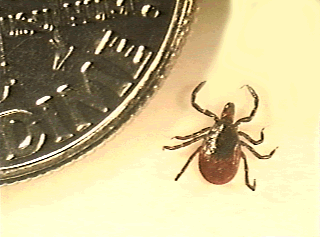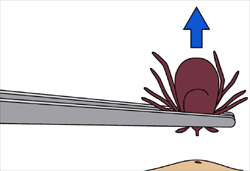Ticks & Lyme Disease
Can I bring in a tick to be tested for Lyme Disease?
Due to the COVID-19 oubreak, the Stratford Health Department is closed to the public. However, you can complete the tick submission form and mail it directly to the Connecticut Agricultural Station. In addition, please email the Stratford Health Department a copy or your form to lwilliams@townofstratford.com. If you are unable to copy your form, please inform us through phone or email that you submitted a tick to the Agricultural Station and provide us with your contact information.
Please note, the Connecticut Agricultural Station is testing ticks at this time, however, that may change should the laboratory's priorities change.
Please follow the following instructions:
• Completely
fill out the tick submission form. (Be sure to include your email address)
• Place
the tick in a plastic sandwich bag and seal tightly
• Place a
label on the outside of the bag with your name
printed on it
• If you
do not have a label place a small piece of paper inside the bag with your name
• Fold the
form with the tick enclosed and place it in an envelope
• Mail the
envelop to the address below:
Attention: Goudarz Molaei
Connecticut Agricultural Station
Box 1106
123 Huntington Street
New Haven, CT 06604

Protect Yourself against Lyme Disease
Lyme disease is a serious public health threat in Connecticut today. It was first recognized after an unusual outbreak of arthritis near Lyme, Connecticut in 1975. In 2002, Connecticut had the highest rate of Lyme disease cases of any state. Since then, reports of the disease have continued to increase. It was discovered that ticks were the source for passing the bacteria that causes the disease in humans.
When an infected tick bites a human, the bacteria can enter the bloodstream and cause Lyme disease. The disease causes symptoms such as:
- Tiredness
- Headache
- Chills and fever, and
- Swollen lymph nodes.
- It can also cause a “bulls eye” rash 3 days to 1 month after being bitten.
If Lyme disease is not diagnosed early, it can cause arthritis of joints, nervous system abnormalities and heart problems.
There are some basic steps you can take to protect your family and yourself from the disease.
Check for Ticks and Remove Immediately

Checking the body daily for ticks and removing them immediately is the best way to avoid Lyme disease. Check pets too. If you find a tick on you, your child, or pet remove it immediately. The transmission of the bacteria that causes Lyme disease from an infected tick is unlikely to occur before 36 hours of the tick attaching to you.
To Properly Remove a Tick

The recommended way to remove a tick attached to the skin is with fine-tipped tweezers. Grasp the tick firmly and as closely to the skin as possible. With a steady motion, pull the ticks body away from the skin. Cleanse the area with antiseptic. Do not use petroleum jelly, a hot match, nail polish, or other products-they will not be effective.
Once removed, you can then place the tick (s) in a plastic ziploc bag and bring it to the Stratford Health Department for testing. The Health Department will send the tick out for testing to determine if it had the bacteria that can cause Lyme disease. They will also notify you of the results within 2-3 weeks. You will want to also follow-up with your health care provider for appropriate treatment.
There are other basic steps you can take to help you fight the bite of ticks. They include:
- Avoid tick-infested areas
- Use insect repellents and
- Wear protective clothing
- Avoid tick-infested areas
Avoid those places where ticks live when possible. Ticks favor a moist, shaded environment, especially in areas with leaf litter and low-lying vegetation in wooded, brushy or overgrown grassy areas.
Apply insect repellent
Always wear insect repellent when going outdoors, no matter what time of the day. Applying an insect repellent will reduce your chances of being bitten by ticks and mosquitoes. There are many repellents that have been proven safe and effective. Products that contain the active ingredient called DEET (n, n-diethyl-m toluamide) are recommended. DEET can be used safely on children over the age of 2 years and adults, however children should use a product containing less than 10% of DEET. Repellents should always be applied based on directions provided on product labels. Remember that all age groups are at risk of being bitten.
Wear protective clothing
Wear light-colored clothing so that ticks can be spotted more easily and removed before becoming attached. If you are going to be in areas where you believe there may be ticks, wear long sleeved shirts and tuck pants into socks and boot tops. This will help keep ticks from reaching your skin. Ticks are usually located close to the ground, so wearing rubber boots may provide additional protection.
Following these same steps can also protect you from other tick borne diseases, such as ehrlichiosis and babesiosis, as well as protect you from other insect bites.
|